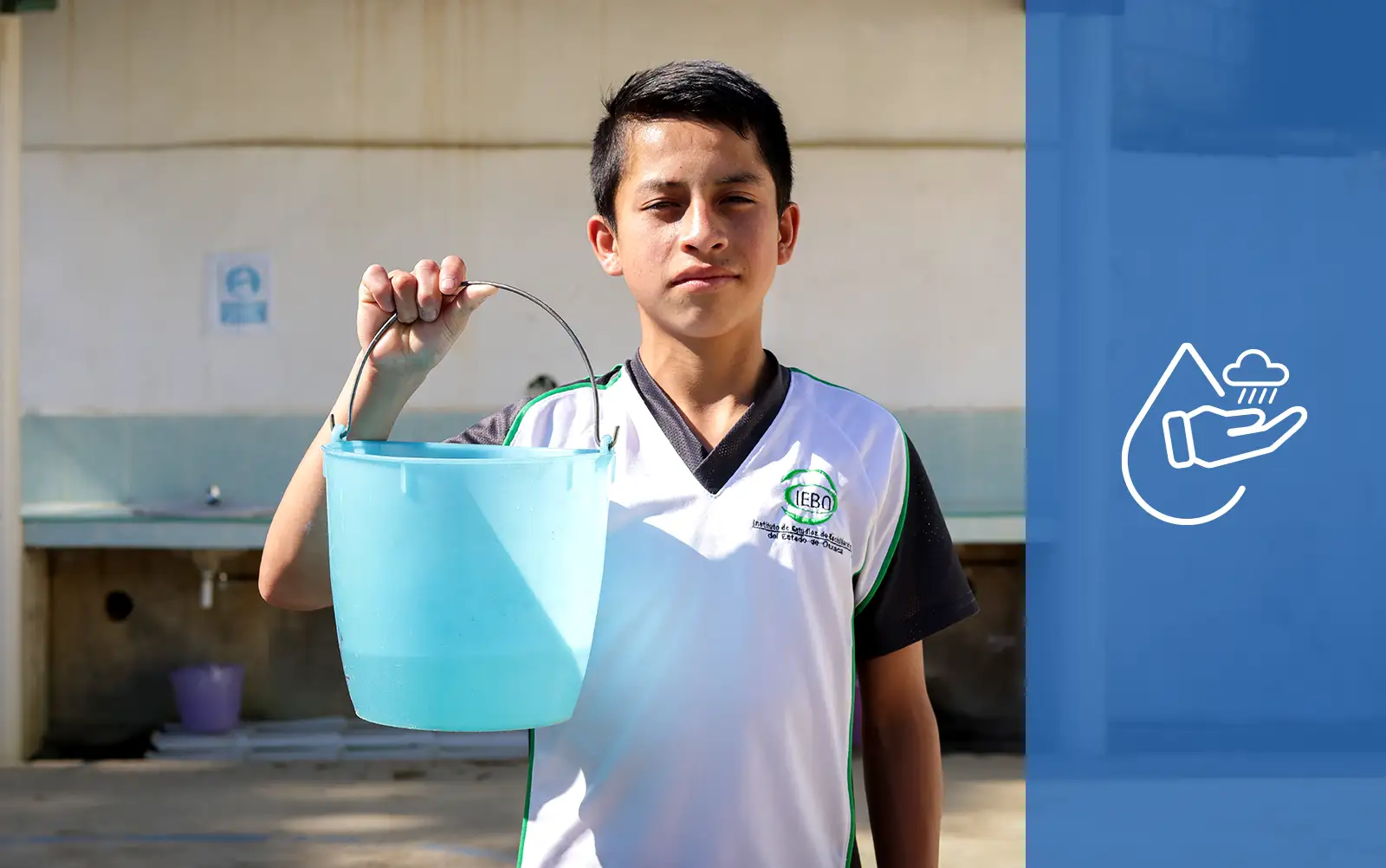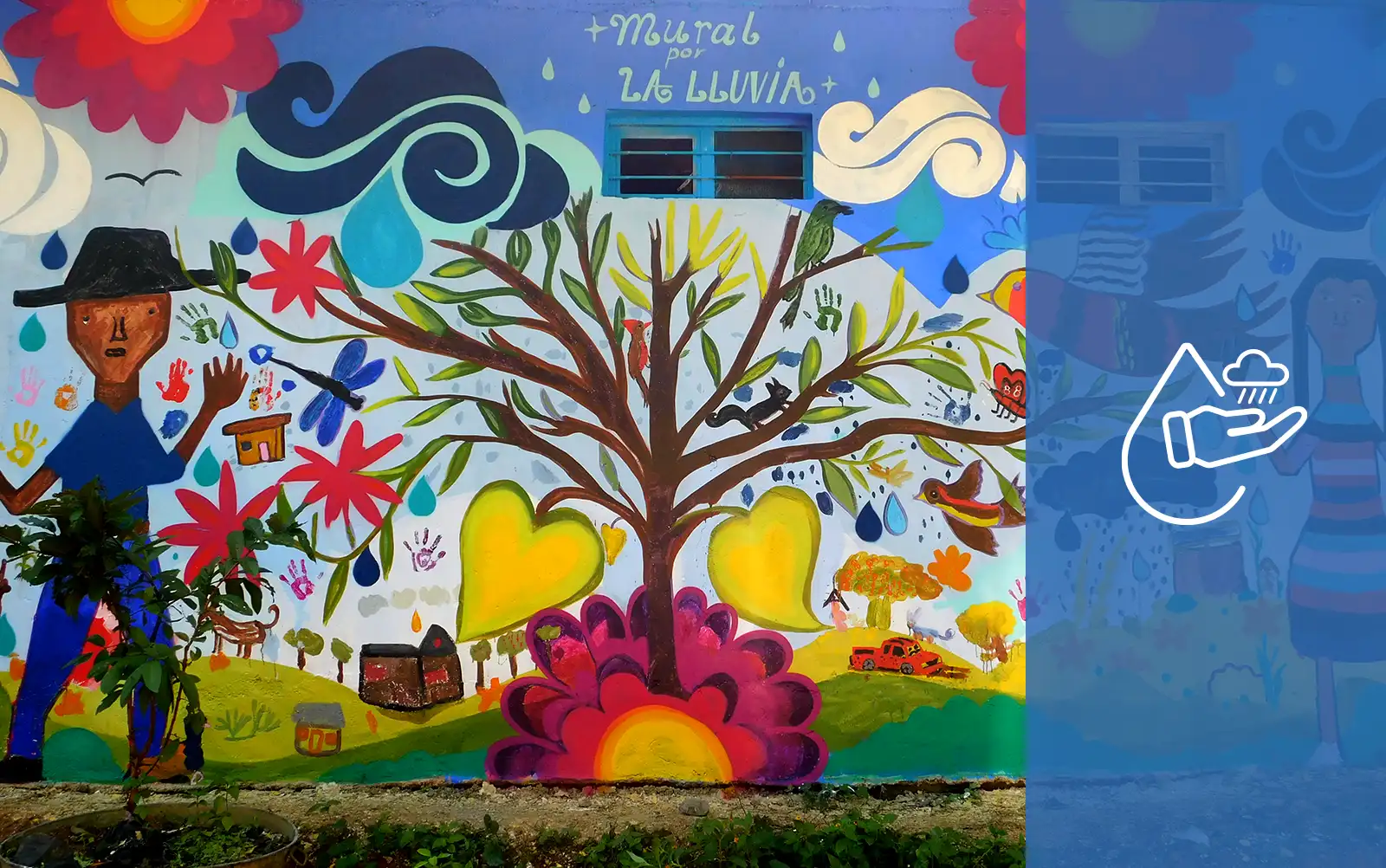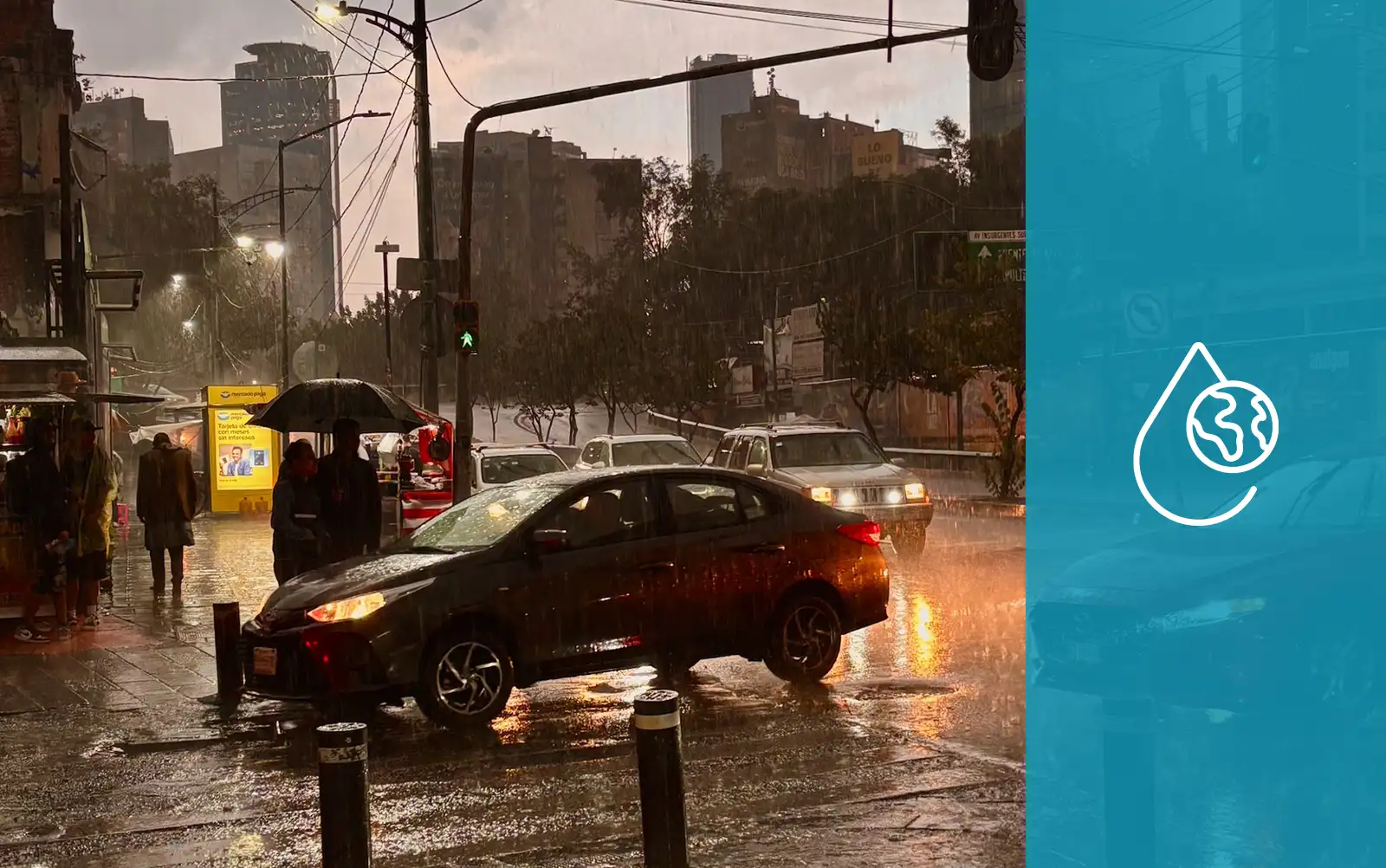
Escuelas de Lluvia: Where Dreams are Sown
By: Sean Donnelly
From the outside, you might not even know it is a school. It doesn’t necessarily stand out among any of the other streetside buildings in urban Toluca. However, shortly after stepping inside the front gate, it becomes readily apparent that Escuela Primaria Cinco de Mayo is a uniquely special place. Director Escolar Samarey Ramírez Ríos has intentionally fostered an environment where school children are not only students: they are changemakers as well. Water was once a serious issue facing the school and now, thanks to the rainwater harvesting equipment and expertise provided by Isla Urbana, it is a tool for empowerment, education, and change.

Isla Urbana launched their Escuelas de Lluvia program in 2018, beginning with just 9 schools in the Mexico City area. These schools were selected out of necessity, characterized as being located in “particularly water impoverished areas” by Escuelas de Lluvia director Ana Paula Mejorada. The program has since expanded to include over 1,000 schools in 28 different states throughout Mexico. Escuelas de Lluvia is also currently working with pilot programs in Panama, Chile, and the Dominican Republic. Mejorada describes Escuelas de Lluvia as “a beautiful program with a lot of soul.” Their primary focus is on increasing water access by implementing rainwater harvesting systems in public schools around the country. The program also places a large emphasis on educating school faculty, staff, and students on maintaining and caring for the systems, once they are put in place. The program aims to help improve the lives of schoolchildren and to aid in their education. According to Mejorada, roughly 6 out of 10 schools in Mexico don’t have access to water. These schools have no choice but to shut down periodically during drier seasons, which causes adverse impacts on the lives of both the students and their parents. Escuelas de Lluvia sees this as too big of a problem to ignore. “The idea is using the rain to empower communities. The educational program is a huge part of this, we are turning adolescent children into changemakers – some schools even have community gardens, turning entire communities agents of change.”
Mejorada estimates that Isla Urbana is averaging around 500-700 new school installations per year. According to the August 2018 edition of the Latin-American Journal of Educational Studies, the average attendance of a primary school in Mexico is 195 students and 246 students for secondary schools. From these statistics alone, one can begin to get an idea of the wide reach and transformational impact of the Escuelas de Lluvia program. Based on those statistics, Isla Urbana is currently expanding their reach to between roughly 97,500 and 172,200 new students per year. Escuela Primaria Cinco de Mayo became one of those schools in April of 2022.
“Prior to the installation of our rainwater harvesting system, we were not connected to the municipal water network” Ramírez Ríos recalled, “We got water every two weeks, provided via hoses from the surrounding mountains. The water was regulated by a local water committee, that existed as an entity independent from the local government.” Isla Urbana’s rainwater harvesting system was put into place 3 years ago and its impacts were felt almost immediately. Prior to its installation, the school had to find creative ways to obtain clean water for the children. With the help of some of the school’s parents, they were able to install a small, DIY rainwater harvesting system that could capture and store approximately 250 liters of water at a time, a quantity of water that Ramírez Ríos claims would last the school only 2-3 days. The pre-existing system has been repurposed and incorporated into the system installed by Isla Urbana, as an auxiliary storage tank for non-potable water, mostly used for cleaning.
At times, the school had to rely on costly delivery trucks to fill their underground water storage tank, a service which, at the time, cost approximately 650 pesos. That service has increased to 900 pesos in cost in recent years, owing to inflation. At the frequency at which a school like this one requires supplemental water deliveries, it’s easy to see how those costs can add up. Furthermore, the Mexican government is only capable of providing so much financial assistance to these schools, so the burden of subsidizing these schools’ water supply often falls on the parents of the schoolchildren, an additional financial burden many families are ill-suited to take on. In times of extreme water shortages, the school was left with no other choice but to close its doors. For the developing minds of young students, missed classroom time can have cascading impacts, impacts which can eventually permeate into Tolucan society at large.
Not unlike the issue in residential homes, public schools in cities and throughout the Mexican countryside also lack reliable and consistent access to clean water. In communities with access to their municipal water supply, water flows inconsistently. In one in three schools in Mexico, students consume contaminated water, exposing children to waterborne diseases such as diarrhea, typhoid, and cholera. These illnesses can cause malnutrition and hinder cognitive development, resulting in decreased academic performance and increased absenteeism (worldysnews). When water is especially scarce, schools often must resort to canceling classes. Moreover, when classes are in session, inconsistent water availability often leaves schools with unsanitary washrooms. Resulting waterborne illnesses lead to increased absenteeism. This, again, impacts young girls disproportionately, who are often forced to stay home during menstruation. Issues stemming from inconsistent access to clean water have led to a 4.2% decrease in students’ grade levels, with older children potentially losing an entire academic year (Dhongde, S., & Spyrou, I. M.).
In rural areas, numerous schools operate without running water, making it difficult to maintain hygiene standards. For instance, in the Soconusco region, over 200 schools have reported water shortages, forcing closures and disrupting the learning process (Blue Community). Natural disasters exacerbated by climate change, like Hurricane Otis in 2023, damaged over 1,000 schools and left approximately 185,000 children out of school in Guerrero (MirageNews). Vulnerable communities in rural areas are disproportionately impacted by water shortages; In 2014, 14.8% of multi-grade indigenous schools reported no daily water availability—a situation that remains largely unchanged (Sánchez, M.)

Ramírez Ríos wants his schoolchildren to develop an understanding and ownership over the water issue at the school and, as such, has given the children some level of responsibility over the water harvested from their rooftops. Walking through the courtyards that lie between the red and white brick walls of the classroom structures, one will quickly notice the series of small to medium-sized garden beds decorating the property, where everything from small decorative flowering plants to full-sized fruiting peach and plum trees, grow happily in the Tolucan sun. Ramírez Ríos has used these gardens as a vehicle for instilling a deeper understanding of the importance of sustainable water usage and the imparting of important life skills, like intentional plant cultivation, into the minds of his young students. The school is planting seeds in more places than their garden beds; Ramírez Ríos hopes that if this generation of children grow up with sustainability-adjacent ideas in mind, they will be better-suited to navigate the climate-related challenges the next century is likely to bring. He believes the Tolucan community has already begun to harvest the fruits of that labor.

Ramírez Ríos supervises as schoolchildren fill watering buckets from a Tlaloque.
The schoolchildren are actively taught to care for and maintain the rainwater system. Now, students who previously had to miss classes due to insufficient water supply are coming home from school with stories of using water flushed from the schools’ Tlaloques, for example, to help water the schools’ gardens. “Because of the school’s example, houses around the community have implemented their own rainwater harvesting systems.”
As he showed me around the school grounds, Ramírez Ríos would periodically poke his head into classrooms to announce it was time to water the gardens. He would then ask for volunteers to help out in the process, and every time, a mass of small hands would extend into the air to offer assistance to the collective cause. The lucky students who were selected to help would then enthusiastically grab plastic buckets stored in each of the classrooms to fill with water from the numerous Tlaloques located around the property. Seeing the young faces of students light up and beam with excitement at the opportunity to be a part of the day’s garden maintenance left me with a profound feeling of hope for this young generation. Watching the daily watering routine, I was left with the impression that these students were not helping out because it was expected or required; they were helping the process because they wanted to be a part of it. Young schoolchildren will typically resist such chores as being tedious and/or boring, but not here in Toluca. The pride these children felt for the gardens adorning their schoolyard was something palpable.

What struck me most during my visit to Escuela Primaria Cinco de Mayo wasn’t just the infrastructure or the garden beds—it was the pride and ownership visible in the faces of students and staff alike. For them, this is more than a water system; it’s a daily lesson in self-reliance, care for the environment, and collective effort. As the students eagerly raised their hands to water the gardens, it became clear: this generation is not just learning about sustainability—they’re living it. In a place where water scarcity once disrupted learning, it’s now being used to cultivate something deeper: resilience, community, and hope.
Sources:
- Blue Community. (2025, February 11). Mexico: 200 schools without water https://blue-community.net/2025/02/11/mexico-200-schools-without-water/
- Dhongde, S., & Spyrou, I. M. (2023). (PDF) impact of drought on children’s educational outcomes. https://www.researchgate.net/publication/373441015_Impact_of_Drought_on_Children’s_Educational_Outcomes
- Mirage News. (2023, November 10). Mexico: Post-otis, Families Starve, children miss school. https://www.miragenews.com/mexico-post-otis-families-starve-children-miss-1120936
- Sanchez, M. (2020, October 12). Rural Mexican schools provide education – not running water. Global Press Journal. https://globalpressjournal.com/americas/mexico/rural-mexican-schools-provide-education-not-running-water/
- Sanchez, M. (2020, October 15). Dry sinks and toilets plague many of Mexico’s public schools, forcing government to fix pipes and install water fountains. Global Press Journal. https://globalpressjournal.com/americas/mexico/dry-sinks-toilets-plague-many-mexicos-public-schools-forcing-government-fix-pipes-install-water-fountains/
- Water.org (n.d.). The Water Crisis Impact on Children’s Education. https://water.org/our-impact/water-crisis/childrens-and-education-crisis/
- Worldysnews. (2024, June 17). In one in three schools, students consume contaminated water – worldys news. https://www.worldysnews.com/in-one-in-three-schools-students-consume-contaminated-water/

